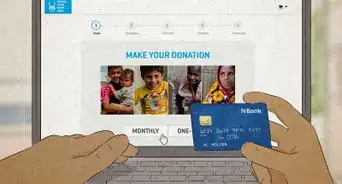This article was co-authored by Direct Relief. Direct Relief is an award-winning humanitarian aid organization, active in all 50 states and more than 80 countries. They focus on helping people affected by emergencies and natural disasters. Direct Relief has been highly rated by Charity Navigator, GuideStar, and the Center for High Impact Philanthropy at University of Pennsylvania, for their effectiveness, efficiency, and transparency.
There are 8 references cited in this article, which can be found at the bottom of the page.
This article has been viewed 36,694 times.
There are people in every city who are in need. They may not be able to afford food, clothes, or other basic necessities. You may want to help but are unsure how to go about it. You will want to make sure that your donation goes to a worthy recipient. It is also a good idea to donate through a reputable organization. There are several steps you can take to donate to people in need, and this article will show you how.
Steps
Deciding Where to Donate
-
1Gather information. If you already know which organization you would like to donate to, you simply need to phone the office and ask them about their donation procedure. However, if you're like many people, you may be unsure of which organization you would like to offer your resources to. Your first step is to start gathering information about your many options.[1]
- First, spend some time learning about different types of donations. For example, would you like to donate money? Or would you prefer to donate materials, such as food or clothing?
- Once you have decided on what type of donation you would like to make, you can start looking for the right place to donate.
- Take notice of your surroundings. Many charitable organizations advertise in public places. Pay attention to the advertisements at the bus stop, or on the notice board at your local coffee shop.
- Look for specific information. For example, if you want to donate toys, try asking a local school for information about charities. A local church can usually provide that information, too.
-
2Think about your priorities. There are many worthwhile causes. Since it's not possible to help every group, spend some time thinking about what matters most to you. Is there a cause that is personal to you? For example, do you have a family member who has suffered from cancer? Consider donating resources to cancer research or toys to a children's hospital.[2]
- Maybe you feel strongly that donating food to the needy is the most important use of your resources. Try reaching out to local food banks to ask them about their needs.
- Think about where you would most like to see your resources at work. For example, have you seen people suffering in the bitter cold? Consider finding an organization that accepts winter coats, gloves, hats, etc.
Advertisement -
3Consider your options. Once you have decided what type of donation you would like to make, it is time to think about whether you would like to donate locally or globally. If you would like to donate toys to a local school, for example, you will want to donate locally. But if you would like to donate money to a larger cause, like environmental research, you may want to look for a global organization.[3]
- Giving locally is a logical choice. It is your instinct to help others around you, so don't be afraid to make that choice.
- Be aware that giving globally is also a good option. People in developing countries live on much less money per day, so your donation can be stretched much farther.
- When you are considering giving to an organization, feel free to ask them to provide some basic information. For example, ask what percentage of monetary donations go to people in need and what percentage is used for administrative costs.
-
4Make sure the organization is reputable. You want to make sure that your money or materials are actually being given to people in need. Charity Navigator, the BBB Wise Giving Alliance, and Charity Watch are excellent resources for evaluating the effectiveness of charities. You can also visit the Internal Revenue Service website to see whether the charity is eligible to receive tax deductible donations.[4]
- In addition, do a basic internet search to make sure the charity has not been reported for scams.
- If someone phones you asking for a donation, ask for more information. Then, phone the charity to make sure they are aware someone is soliciting funds in their name.
- Do not send cash donations. For security and tax reasons, it is safer to donate by writing a check.
-
5Ask for advice. Wherever you decide to donate, you want to make sure that you are choosing a reputable organization. That means that the money is going to help those in need. Ask friends and family if they have a charity that they support.
- If you belong to a church, you can ask if there are church-approved organizations you can give to.
- Neighbors are also a great resource. Post a notice in your apartment building asking if anyone knows of a worthwhile local organization.
Making a Donation
-
1Consider your own resources. Once you have chosen an organization, it is time to decide how much you can donate. Take some time to think about what you can afford to give. If you are making a monetary donation, take a look at your budget. Make sure that you can afford the amount you choose to give.[5]
- The same principle applies if you are donating material goods. It's great to donate gently used clothing, toys, and household goods. Just make sure that your own family members are done needing those items.
-
2Gather your materials. Once you have decided what you can afford to give, spend some time organizing your donation materials. For example, if you have decided to donate food, take a few minutes to go through your pantry and look for canned or dry-goods that have a long shelf life. Make sure that the items are not expired.[6]
- Contact your local food bank to ask for specific guidelines. For example, food banks generally do not except homemade goods or any items in glass containers.
- If you are donating to a shelter, make sure to keep personal care items separate from food. You can collect items such as soap, toothpaste, and toilet paper.
-
3Donate your time. Maybe you are not in a position to donate money or materials. You can still help people in need. Consider becoming a volunteer and donating your time.[7]
- Use the same process to decide which organization to give your time to. Consider your priorities and what types of resources you have to give.
- For example, if you enjoy working with kids, you could consider volunteering for a mentoring program such as The Boys and Girls Clubs of America.
-
4Contact the organization. Once you have all of your resources gathered, call or e-mail the organization you wish to donate to. The business office will be able to tell you the procedure for making a donation. For example, many food pantries only accept donations on certain days and at specific times.[8]
- Many organizations offer a pick-up service. Ask for more information about this, particularly if you are donating several items, or a large item such as a piece of furniture.
- If you want to become a volunteer, ask if there is an orientation session or training program that you need to complete.
Following Up With the Organization
-
1Ask for updates. When you make a donation, you might want to follow up and make sure that your money or materials were put to good use. Many organizations can provide data about how they disperse funds and aid. This is particularly true true of international and national organizations.[9]
- Sites such as JustGive.org can help you find reputable organizations. Well-established and funded organizations may be more likely to be able to tell you how your donation will be used.
- Subscribe to the organization's list-serve so that you get e-mail updates. You may also receive materials such as monthly newsletters.
-
2Follow the news. Keeping an eye on current events can help you keep track of which organizations are helping those in need. For example, when there is a natural disaster, you will often see news reports about the American Red Cross and their efforts.[10]
- When there is a local disaster, the news will often report on what materials are needed and how to donate them.
-
3Make a deduction. When you make a charitable donation, you can often make a deduction on your tax return. You will need to itemize your donations in Section A of your 1040 tax form. Keep track of all items you donate.[11]
- Ask your accountant to make sure that you are receiving the proper credit for all of your charitable giving.
References
- ↑ http://www.charitynavigator.org/
- ↑ http://www.charitynavigator.org/
- ↑ https://reg-charity.org/giving-locally-vs-globally-where-can-we-do-the-most-good/
- ↑ https://www.consumer.ftc.gov/articles/0074-giving-charity
- ↑ http://www.redcross.org/support
- ↑ http://www.feedingamerica.org/ways-to-give/give-food/food-drives/
- ↑ https://www.volunteermatch.org/
- ↑ http://www.feedingamerica.org/ways-to-give/give-food/food-drives/
- ↑ http://www.cnet.com/how-to/make-sure-your-donation-gets-to-the-people-who-need-it/


































































